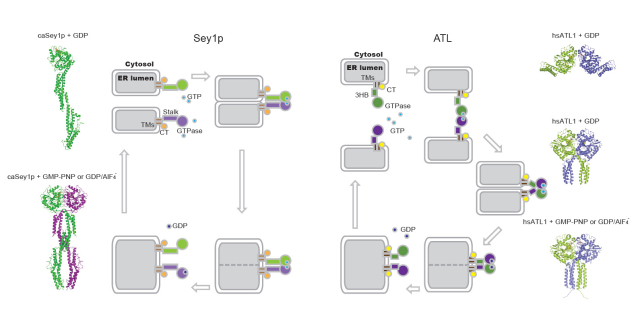New insight into homotypic ER fusion mediated by dynamin-like GTPase
Membrane fusion is a critical process in supporting various cellular activities. Most of the previous studies are focused on the heterotypic membrane fusion, such as SNARE mediated vesicular membrane fusion, but little is known about the homotypic membrane fusion, which connect organelles including the endoplasmic reticulum (ER) and mitochondria.
Dysfunction of ER membrane fusion leads to hereditary spastic paraplegia in human. Previous work by HU Junjie of IBP and others has identified a class of membrane-bound dynamin-like GTPases named atlastin (ATL) that meditates ER homotypic membrane fusion. But not all eukaryotic organisms express ATL. Another family of GTPases, Sey1p in yeast and RHD3 in plant, was found to be functional ortholog of ATL. However, Sey1p and RHD3 are much longer than ATL, and have different distribution along ER membranes, indicating a different mechanism.
In a recent study published online by The Journal of Cell Biology on Sep. 14, 2015, entitled Structures of the Yeast Dynamin-like GTPase Sey1p Provide Insight into Homotypic ER Fusion, Prof. RAO Zihe’s and HU Junjie’s groups from IBP have illustrated the molecular mechanism of homotypic membrane fusion mediated by yeast ER fusogen Sey1p. This work presented a previously unidentified configuration of the dynamin superfamily, and the fusion process by Sey1p and ATL was compared.
Prof. RAO Zihe’s group successfully determined the structures of candida albicans Sey1p with different GTP analogues. HU Junjie’s group tested Sey1p functions using biochemical and cell biology assays, and found that Sey1p and ATL have similar membrane fusion steps but the power stroke of fusion reaction occurs at different stages. Sey1p can mediate fusion without GTP hydrolysis, even though fusion was much more efficient with GTP. In addition, the punctate localization of Sey1p was dependent on its GTPase activity.
The research has broadened people’s understandings on how membrane fusion is achieved and laid a solid foundation for the future studies in this area.
Because of Dr. HU Junjie’s contribution to the field of ER membrane fusion, he was interviewed by the “People & Ideas” of JCB recently, which showed the interviewer's interest and concern in this research field. (More information to see: http://intl-jcb.rupress.org/content/209/5/626.full )
Figure legends: Models for fusion mediated by Sey1p and ATL. The structures of Sey1p determined in this study were shown on left. The structures of ATL reported previously were shown on right for comparison. (image by HU Junjie's Group)
Contact:
HU Junjie
Institute of Biophysics, Chinese Academy of Sciences
Website: http://english.ibp.cas.cn/ibp_pi/HK/201311/t20131112_112436.html
Email: huj@ibp.ac.cn


